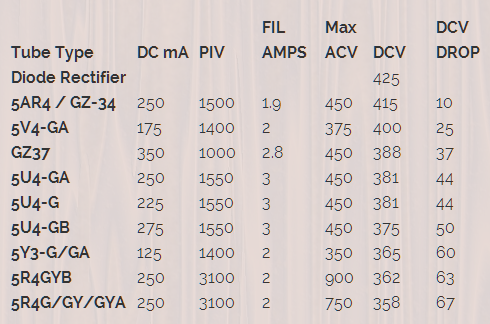In my new Deluxe Reverb build, I was using a JJ GZ34S. 6V6 plates at 460v, and bias about 15mA each tube.
I thought I'd try a 5U4GB to lower the plate voltage, but after setting the bias to 16mA, the plate voltage is 440v. Why only a 20v change?

Moderators: pompeiisneaks, Colossal

It's a bit too simple to even state a condition like 'max rated current', especially for the ubiquitous capacitor input filter rectifying circuit - where the current through the diode is most like a half-sine shape (ie. its average and peak values are quite different). And what makes it harder to comprehend is that the DC load current drawn from B+ by the amplifier circuitry is not the same current value as either the diode peak current or the diode average current.
As I mentioned, you can tailor the relative voltages with a power resistor after the rectifier tube. Something between 22R and 100R would be a useful range.
A few questions about putting diodes in series with a tube rectifier:
A word of warning: The dropping resistor will get very hot. A 10W ceramic box type is probably too small. Leave room for three or four in series with lots of air around them. Mount them up off any PCB, eyelet or turret board.
Yes, and no, depending on how you look at it.
Ordinary 1N400x diodes have an abrupt shutoff of current when they turn off. This can in some circumstances be so abrupt that it makes the parasitic inductance and capacitance of the wiring to/from the diodes ring with squarks of RF; these can sometimes be rectified by the audio into a low level RF buzz. This is the reason that you will sometimes see solid state diodes paralleled by a capacitor or resistor + capacitor to snub the RF bursts. FREDs (and tube rectifiers) have a soft turn off that does not excite ringing like ordinary silicon diodes. That's why FREDs. But careful snubbing can do the same. I just like not having to tune snubbers if FREDs do it naturally. FREDs are more expensive than the 1N4007, but not horribly so when you compare them to the cost of repairs when a rectifier tube shorts. I had a mental image of the cheaper FREDs being about $1 each. Mouser shows this has risen to about $1.40 now. You'll probably need four, so you're up for something under $6.00.Why a FRED over something like a 1n4007? Are they just better diodes and not much more expansive?
Probably. The cheaper FREDs are rated at 1200V, 10A each. They're loafing in terms of current, but you might need two in series for the voltage. This gets you to about 2400V. For a B+ of ~500V, you have 500V on the first cap, and another 500V across the reversed diode, something in the 1000 to 1200V range. A 1200V FRED might be OK. I personally would put in two FREDs in series because I'm an engineer, and we compute everything to six decimal places, then double or triple the answer for reliability.Don't you probably need more than than one of these safety diodes on each side of the transformer? This discussion seems to indicate that the diodes should be rated around 3x the PIV of the transformer winding: https://ampgarage.com/forum/viewtopic.php?f=4&t=14461
I don't think that they're purely cosmetic necessarily. There is a continuum of effects.
If the tube rectifier becomes more or less glowing cosmetic item when the safety diodes are installed then I'd guess it could more or less completly replaced by the safety diodes and a dropping resistor (for sag)?
Absolutely correct! My personal preference is to spread the heat out into several resistors that series and/or parallel to the right resistance. It's more complicated mechanically, but you get a lower temperature hot spot than in one very high power resistor.